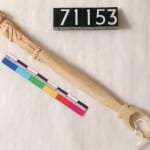The mysteries of the Egyptian hairstyles
By Edmund Connolly, on 3 June 2013
Collection Correspondent: Monika Zgoda
Please note this post contains images of human remains.
The allure of the Ancient Egypt, scented with the air of mystery has been enchanting generations, and while more and more of its secrets are now being discovered, it seems some of its riddles are still waiting to be solved. One of such is right here at Petrie, and although sadly it is not the Sphinx (we wish!), its beauty and whimsical charm are of equal quality.
While the use of make up and cosmetics in the Ancient Egypt has been widely covered, and we are now familiar with the various aspects of it – from the religious and spiritual connotations to its more practical uses – there is still some mystery regarding the cosmetic equipment used.
Intriguingly catalogued as “bone cosmetic object of uncertain function “ this peculiar artefact dates back to the Roman Period and its purpose remains unknown. Could it be a hair curling devise? Despite the common misconceptions the Egyptian women did not monotonously sport the raven black bob – studies conducted on various mummies show that braiding, plaiting, curling and even hair extension were popular amongst the Egyptians. One of the mummies discovered in the KV35 cache was Queen Tiye, the grandmother of the famous boy king Tutankhamun – to this day she astonishes with her beautifully preserved auburn hair, which rests around her face in soft waves. Could she have used a similar curling tool to our cosmetic object of uncertain function?
It’s important to remember that cosmetics and beautifying procedures were a part of everyday life not only for Egyptian women but also men, regardless of their social status. Mummies of both genders, discovered in Dakhleh Oasis cemetery in Egypt’s Western Desert confirm this theory, proving that the fashion conscious Egyptians used variety of substances, similar to our hair styling products now, to achieve various hairstyles – in both life and death. Archaeologists discovered that many of the preserved bodies had their hair styled during the process of mummification, in the preparation for the afterlife and their meeting with Osiris. Providing another clue to the mystery of our bone carved object, is the fact that the bodies found in Dakhleh Oasis were excavated from a Greco-Roman cemetery.

Hairdressing scene of Queen Nefru, 11th Dynasty, Deir el-Bahari, Brooklyn Museum. copyright Dr. Joann Fletcher
The female figure carved on one end of the artefact is believed to be Aphrodite – a clear indication of the Greek influences on the Egyptian culture, which took place after the defeat of Queen Cleopatra VII when Egypt became the Roman Province in 30BC. As the native Egyptian culture began to slowly disappear and the Roman culture became more prominent, the inevitable clash and mix of styles occurred. Could it then be that our mysterious object was an instrument in this evolution of the Egyptian hairstyle history, used to style Egyptian hair into Roman curls? Could the silent narrative of this mysterious artefact be a powerful reflection of the rapid changes which marked the end of one of the most important ancient civilisation? Perhaps we will never know anything more about this object, and perhaps that’s part of its appeal. Why not examine it further next time you’re at Petrie, and who knows? Maybe it will whisper to you its unspoken story?
After working in the fashion industry for a number of years, Monika is now pursuing a career as a fashion historian, discovering the ethnographic and anthropological origins of clothing and jewellery.
2 Responses to “The mysteries of the Egyptian hairstyles”
- 1
-
2
Josephine Bonnar wrote on 17 September 2018:
What tools , equipment did egiptions use to style there hair in horstical times
 Close
Close




I would suggest that Monika Zgoda contacts Janet Johnstone (Friends of the Petrie Museum) to learn more about the construction of Egyptian clothing as she is the world expert on this subject.